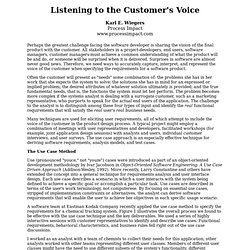

The product owner and the product-shaped hole - Why what the product owner needs to worry about isn't in the product backlog. What the product owner needs to worry about isn’t in the product backlog If you’ve read one of my blog essays before, you know this isn’t going to be a quick thought, but a bit of a long discussion (read “discussion” as “rant”).

This particular discussion describes what I see as a problem in agile development – sort of a practice vacuum. One of the most difficult roles in an agile process is the product owner or agile customer. In this essay I describe the problem as I see it, and sketch what I see as a mental model and some practices that product owners can use to begin to fill that skills vacuum. Warning, it’s a bit of a long rant.
Identifying Requirements Through Use Cases. Perhaps the greatest challenge facing the software developer is sharing the vision of the final product with the customer.

All stakeholders in a project-developers, end users, software managers, customer managers-must achieve a common understanding of what the product will be and do, or someone will be surprised when it is delivered. Surprises in software are almost never good news. Therefore, we need ways to accurately capture, interpret, and represent the voice of the customer when specifying the requirements for a software product. Often the customer will present as "needs" some combination of: the problems she has in her work that she expects the system to solve; the solutions she has in mind for an expressed or implied problem; the desired attributes of whatever solution ultimately is provided; and the true fundamental needs, that is, the functions the system must let her perform. The Use Case Method.